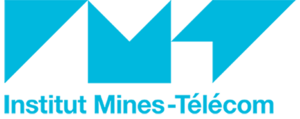Institut Mines-Télécom facts for kids
 |
|
| Type | Public, Grand établissement EPSCP |
|---|---|
| Established | 1996 |
| Chancellor | Odile Gauthier |
| President | Olivier Huart |
|
Administrative staff
|
4,450 |
| Students | 12,300 |
| Postgraduates | 1,560 |
| Location |
Albi, Alès, Brest, Douai, Evry, Gardanne, Lille, Nancy, Nantes, Rennes, Paris, Saint-Étienne and Sophia-Antipolis
,
48°42′46″N 2°12′01″E / 48.7128°N 2.2003°E |
| Website | http://www.imt.fr/en/ |
Institut Mines-Télécom (IMT) is a group of public schools in France. These schools focus on higher education and research. They specialize in engineering and digital technology. IMT helps create new ideas and solutions for the future.
IMT was started in 1996. It was first called "Groupe des écoles des télécommunications." Later, it became "Institut Télécom." In 2012, it joined with the "Mines" schools and changed its name to Institut Mines-Télécom. It is now a "Grand établissement," which means it's a very important public institution.
IMT works closely with businesses. It focuses on three big changes happening in the world today:
- Digital technology
- Energy and the environment
- Industry
Many new companies start from IMT's special programs each year. The schools in IMT are known as Grandes Écoles. They are approved to give out the French engineering degree called the Diplôme d'Ingénieur.
Contents
History of IMT
How IMT Started
In 1996, a big change happened in France. The company France Télécom no longer had a complete monopoly on telecommunications. This meant other companies could offer phone and internet services.
To manage the schools that taught about telecommunications, a new group was formed. This group included three main schools:
- École nationale supérieure des télécommunications
- École nationale supérieure des télécommunications de Bretagne
- Institut national des télécommunications
This group was first called the "Groupe des écoles des télécommunications."
Becoming Institut Mines-Télécom
In 2008, the group changed its name to "Institut Télécom." Then, on March 1, 2012, it changed again to "Institut Mines-Télécom." At this time, six "Mines" schools joined the Institut. These schools were focused on engineering and industry. They came from under the Ministry of Industry. This merger made IMT a bigger and more important institution.
What are Grandes Écoles?
All the schools that are part of Institut Mines-Télécom are called Grandes Écoles. In France, these are special higher education schools. They are separate from the main public university system but work alongside it.
Why are they Special?
Grandes Écoles are known for being very good schools. They are similar to top universities in other countries. Getting into a Grande École is very competitive. Students have to pass difficult exams. Many students who graduate from these schools go on to hold important jobs in government and big companies in France.
How to Get In
Most French students who want to join an IMT school first go through a two-year program called prépa. This program helps them prepare for the tough national entrance exam. After passing the exam, students can start their studies at a Grande École. The full program usually takes five years after high school. It ends with a Master's degree.
International students can often apply directly after high school or after getting a bachelor's degree.
What Students Learn
Even though Grandes Écoles can be more expensive than regular public universities, they often have smaller class sizes. Many programs are taught in English, which is great for international students. Students also get chances to do internships abroad and study in other countries. These schools have strong connections with businesses and government.
The degrees from Institut Mines-Télécom are recognized by important French education authorities.
Schools of IMT
Institut Mines-Télécom includes eight main schools:
- IMT Atlantique: Located in Brest, Rennes, Nantes, and Toulouse. This school was formed in 2017 by combining two older schools.
- IMT Nord Europe: Found in Lille and Douai. This school also formed in 2017 from a merger.
- Télécom Paris: Located in Paris and Sophia Antipolis.
- Télécom SudParis: Located in Évry.
- IMT Mines Albi-Carmaux: Located in Albi.
- IMT Mines Alès: Located in Alès.
- Mines Saint-Étienne: Located in Saint-Étienne.
- Institut Mines-Télécom Business School: Located in Évry and Paris. This school focuses on business.
Working with Partners
Institut Mines-Télécom works closely with other important organizations and schools. These partnerships help with research and education.
Strategic Partners
Some of IMT's key partners include:
- ARMINES: A research group linked to the Mines schools.
- École nationale supérieure des mines de Nancy: Another engineering school.
- Institut Des Mines De Marrakech: A school in Morocco.
- TUM: A university in Germany.
Associate Schools
IMT also has eleven associate schools. These schools work with IMT on different projects and programs:
- Télécom Nancy in Nancy.
- Télécom Saint-Étienne in Saint-Étienne.
- Télécom Physique Strasbourg in Strasbourg.
- ENSEIRB-MATMECA in Bordeaux.
- Sup'Com in Tunis.
- INP-ENSEEIHT in Toulouse.
- ENSIIE in Évry and Strasbourg.
- ENSG in Nancy.
- IFMA in Clermond-Ferrand.
- ESIGELEC in Saint-Étienne du Rouvray.
- Grenoble École de Management in Grenoble.
- ENIB in Brest.
- ENSSAT in Lannion.
Student Exchange Programs
IMT has a special agreement that lets students study at different schools within the Institut Mines-Télécom group. This means a student might start at one IMT school and then spend their third year at another. This allows students to experience different subjects and options available at various schools. This agreement includes all 10 IMT schools, two affiliate schools (Eurecom and Télécom Lille 1), and a strategic partner (Mines Nancy).
See also
 In Spanish: Institut Mines-Télécom para niños
In Spanish: Institut Mines-Télécom para niños
- Grands établissements
- Grandes écoles
External links
- Institut Mines-Télécom official website: http://www.imt.fr/en/

